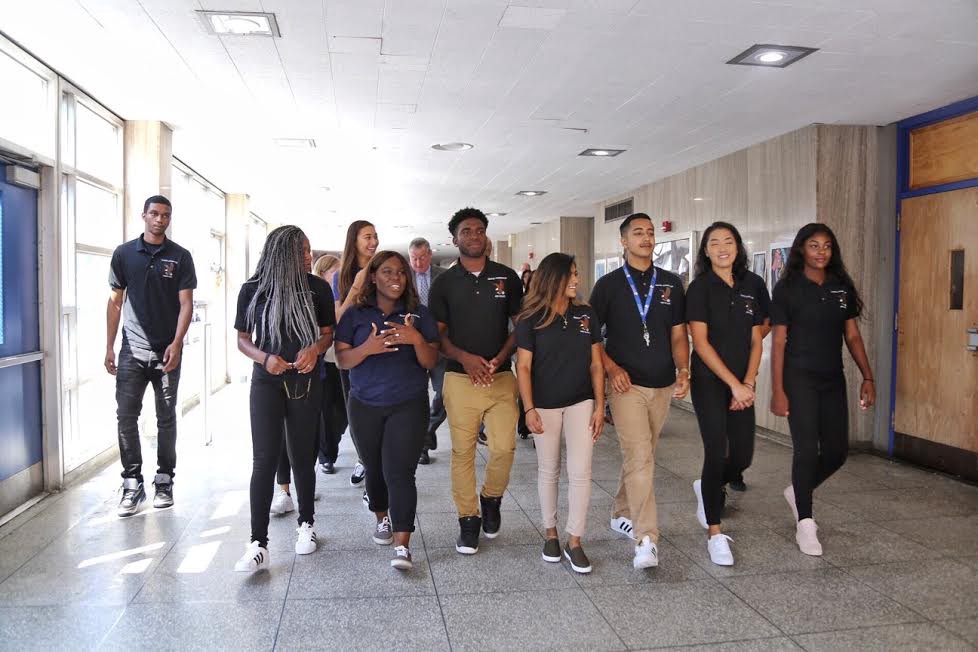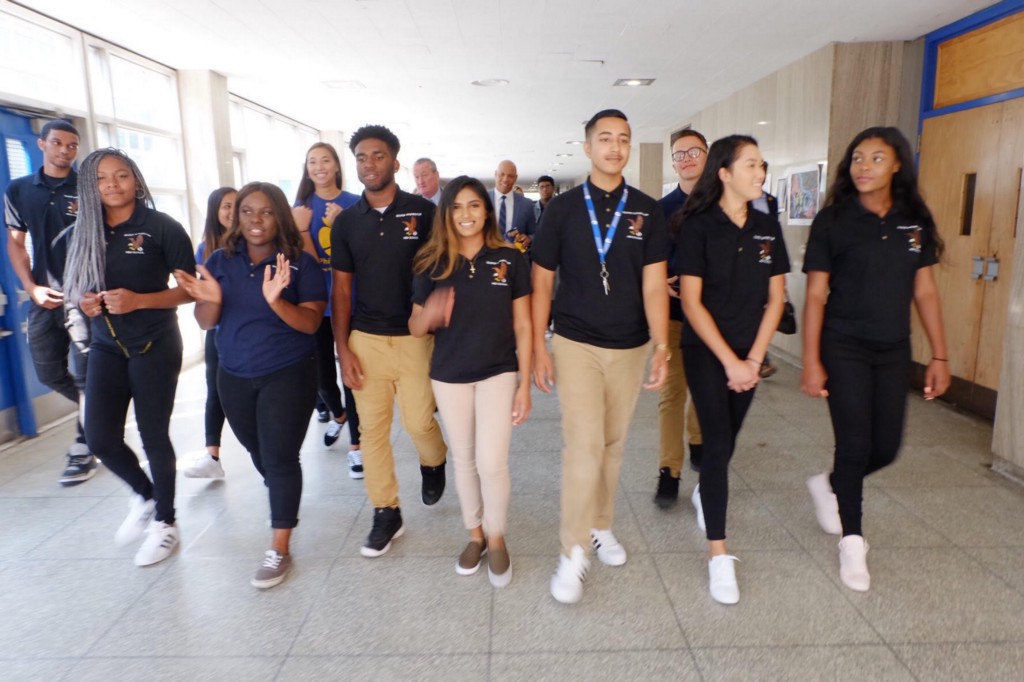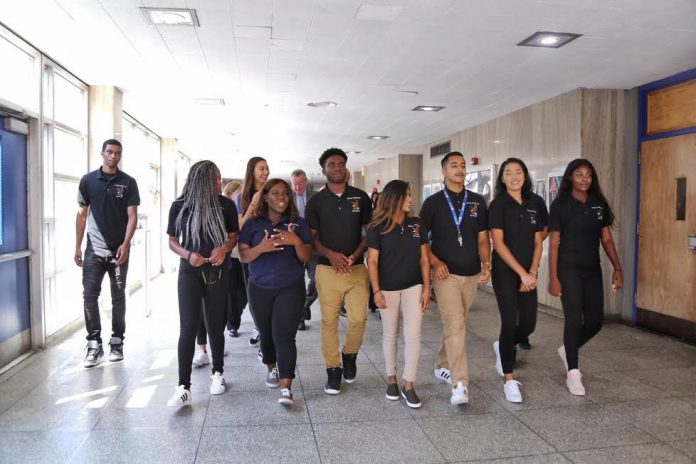By becoming a community school and letting students’ voices be heard, George Washington High is quickly turning itself around.

Elene Tsopurashvili cried when she heard she was going to George Washington High School.
She started attending the school halfway through the 2014–15 school year as a freshman.
“My family just moved from the Republic of Georgia, and everyone was telling me not to go,” she said.
When she arrived, she was placed in a math class below her skill level and felt she was being deprived of opportunities to expand her education.
Sana Ahmadi felt the same way. She had wanted to go to Central High School and was accepted, but circumstances prevented her from going.
“There were fire alarms and fights every day,” she said. “Honestly, I took the school as a joke. I skipped a lot of classes and faced no consequences for it.”
This couldn’t be further from the truth now.
Now seniors, Elene and Sana are proud Washington students, each involved in multiple activities around the school. They both say the school has seen drastic changes starting about two years ago, with the arrival of principal Susan Thompson.
“The school changed drastically a few years ago,” Sana said. “People started to take it seriously and realized it was a good thing.”
The challenges
A few years ago, misbehavior took place frequently. One such incident included three male students bursting into a classroom to try to take a cellphone from a female student in 2015. When the teacher tried to intervene, the students beat the teacher.
That’s just one example of many fights that happened in the school. Add students frequently cutting class and pulling fire alarms as pranks to the list of problems the school faced.
“There was a disconnect between students and teachers, and teachers and administration, in what the real goal was of being in school,” said Thompson, who came to the school in March 2016 as an interim principal before assuming the position full-time at the beginning of last school year.
“Along with that disconnect, there was a lack of student voice and understanding about what their needs were,” she said. “There was also a lack of teacher voice.”
Thompson noted that teachers would lock classroom doors after the late bell rang and not let any late students in for that period. She said they were afraid non-students would come into the room and cause issues.
“Doors were closed, literally and metaphorically,” she said.
The solutions
Thompson was never one to walk away from a challenge. She was able to walk around the school’s blue and yellow halls to familiarize herself with it before accepting the position as interim principal. By seeing it for just a short amount of time, she was able to identify what the school was “really about.”
“I think some people would have been afraid by what news media said,” she said. “Being in the space and seeing the reality, I saw it really wasn’t as bad as everyone thought.”
She couldn’t just walk away.
“There were too many students not being served, and that to me was terrifying,” she said.
One of Thompson’s main objectives coming into the school was to make sure every student and teacher voice was heard.
To accomplish this, Thompson started releasing surveys. Questions ranged from opinions on cafeteria food to if the student feels safe within the school.
The school hosted a spirit day program with the Department of Justice to allow about 45 students from the school’s diverse body to voice their concerns. Based on what the students said, the department offered Thompson and faculty advice after hearing students’ thoughts.
Main points of concern were that they wanted tutors and more support in classes, more counselors, and to feel safe in the building. These have become some of Thompson’s top priorities.
“By asking students and teachers to care more, they have started to care more,” Thompson said. “Each year I opened up the school year reminding the teachers, this is where our students come from.”
Kids also asked for more support for immigrant families.
“It’s one of the most diverse schools in Philadelphia, and I want to make everyone feel respected and heard,” Thompson said.
Thompson said the student body represents around 70 different countries and speaks more than 50 languages.

Student body breakdown
Hispanic/Latino: 2.6%
Native American or Alaska Native: .3%
Asian: 16.7%
Black or African-American: 29.8%
White: 37.2%
Two or more races: 4.5%
Undefined: 9.5%
Total students: 1,285
American Community Survey 2010–2014 showed that 49 percent of people who lived within 1,000 feet of the school were born outside of the United States.
Thompson said to adhere to students requesting family support, she applied for the school to be a community school, a concept fairly new to the city of Philadelphia.
Community school
Caitlyn Boyle was born and raised in Northeast Philadelphia, but never went to George Washington.
Now, she is the school’s Community School Coordinator for the Philadelphia Mayor’s Office of Education. At the beginning of the school year, the city of Philadelphia declared it a “community school,” joining 10 other district schools.
“A community school is meant to meet the needs of that specific community,” Boyle said. “It focuses on the whole child, and is meant to impact all of the things that impact a child’s performance.”
Community school coordinators assess the needs of the surrounding community and bring resources that may help the school.
“Community schools become neighborhood centers, improving access to programs and services for students, families and neighbors,” the website says.
Boyle said community schools aim to address issues like if the student is hungry, feels unsafe or has nobody to provide direction, for a few examples.
Washington was part of the second cohort of community schools announced. The first cohort was announced in 2016. According to a press release from the city of Philadelphia, the goal is to have 25 Philadelphia schools become community schools by 2020.
Boyle began working at the school full time this year. Thus far, they have begun surveying all stakeholders (including family, staff, community members and service providers) to figure out what they want, much like Thompson did.
“It’s my job to figure out where I can find those resources and align what the city already provides to meet those needs,” Boyle said. “I look at all things that impact kids’ education.”
Boyle said the school is still within the research phase. By the end of the year, she will identify the top two or three priorities to address from students and community members, and develop a strategic plan to address those needs. She said based on the surveys conducted so far, one area of focus may be jobs and job training.
One example of what Boyle is working on is having a health access network have regular hours within the building so parents could enroll within the building.
“We thought it was really important to find a school within the Northeast and bring our resources up here,” Boyle said. “Even the nearest health center is five miles away.”
On Saturday, Nov. 4, Washington will host its first community fair to help spread word to the community from 11 a.m. to 3 p.m. Students, families and community members are all invited to participate in activities and acquire information about services.
Helping the community
Community schools are not a concept unique to Philadelphia.
In 2007, the superintendent of Austin Public Schools in Austin, Texas, announced its intention to close the Walter P. Webb Middle School. Webb was the lowest-performing middle school in the city, with enrollment slipping and the graduation rate at 48 percent.
Residents resisted the closure, banding together to develop a strategic plan and opting to implement a community school strategy.
Like George Washington, they began with needs assessment. Many parents of the school are construction workers, day laborers and house cleaners, and may not have education beyond high school. Many are not English native speakers. One of the needs found was that parents and students did not have medical insurance. The school partnered with a mobile clinic to provide free physicals to students in response.
This is just one example of what the community school improved, including introducing a more extensive and engaging curriculum and offering English courses for parents.
Five years later, the school became the highest-performing Title I middle school in Austin, and average attendance sits at around 95 percent.
This isn’t the only example. Ninety percent of Wolfe St. Academy students lived in poverty, and 46.6 percent of them remained at the Baltimore, Maryland, school for more than three years.
In 2014, eight years after becoming a community school, it ranked as the second-highest performing school in the city. It ensured its students were given three meals at school so they wouldn’t arrive or go home hungry.
These are just two of the 5,000 schools nationwide that have adopted the community school strategy.
Voices heard
Now a senior, Elene has carved out her place at Washington.
She’s a member of the International Baccalaureate, a program that allows students to earn a special diploma that could help them be accepted to top universities around the world.
She’s also the captain of the debate team, works on the school newspaper and is a member of the student advisory council and the ESOL outreach program.
“When I came here I felt there was no one to tell me all the opportunities I had at Washington,” Elene said. “With this program, I want to make sure immigrant students had somebody to introduce them to different classes and activities.”
She said the school has played a huge role in becoming the person she is.
Sana has embraced her school pride as well. Walking through the halls, she is able to recite obscure trivia about the building (a section of the building used to be a bomb shelter), and acts as a mentor for about 30 freshmen as part of the Peer Group Connection. She teaches these freshmen lessons on topics like drugs and peer pressure to help acclimate them to the school.
Sana is also in the National Honor Society, the captain of the volleyball team and an AP student.
“Principal Thompson switched things around so you’re not ashamed to say you go to Washington,” Sana said.
While Sana and Elene both say they have seen the school change drastically in just a few years, Boyle said there is much more to come.
“It’s important to note the community school strategy is not a Band-Aid and does not happen overnight,” she said.
Boyle said the first year is going to be about changing the perception of the school and getting the community more involved. She said it could, and likely would, take years to see the school live up to its maximum potential.
“We need to make sure our kids are college and career ready,” Thompson said. “If we haven’t done that, we haven’t done our job for the community, because that’s where they’re going next.”
As the school becomes a community school, students like Elene and Sana were already able to find their place.
“I was able to find my way, and I think in Washington even when there were many problems, if you really tried you would find your spot,” Elene said.
So far, Thompson and Boyle have earned an A for effort. ••
To view and participate in one of the school’s surveys, visit surveymonkey.com/r/CommunitySchoolsPHLCommunity





